National trends in adolescent opioid overdose: The rising tide of deaths involving prescription and illicit opioids
Opioid misuse and related overdose among adolescents and emerging adults are ongoing concerns, but research has yet to fully characterize opioid use patterns and their contributions to overdose among young people. This study revealed that adolescents with a history of prescription opioid misuse are more likely to engage in drug use behaviors associated with overdose risk, and an increasing number of adolescents in the U.S. are dying from overdoses that involve both prescription and illicit opioids.
WHAT PROBLEM DOES THIS STUDY ADDRESS?
Adolescent and young adult opioid misuse is an ongoing public health concern as initiation and experimentation with opioids can lead to continued and riskier use in adulthood including unintended overdose. Experimentation often starts with nonmedical use of prescription opioids and individuals who have engaged in nonmedical prescription opioid use are more likely to engage in heroin use. The synthetic opioid fentanyl, often found in today’s heroin supply and in counterfeit prescription opioids, is involved in a growing number of overdose deaths. Similar to the U.S. population of adults, opioid-related overdoses have increased substantially among adolescents and emerging adults. Between 1999 and 2016, overdose deaths involving synthetic opioids, heroin, and prescription opioids increased 2,925%, 405%, and 95%, respectively, among individuals aged 15 to 19 years.
Learning more about opioid use patterns and the factors contributing to adolescent and young adult overdose can help us improve prevention and intervention efforts to help curb these rising rates. Although research has started to characterize opioid use and overdose among adolescents and emerging adults, studies have yet to identify the prevalence of overdose deaths that involved both prescription and illicit opioids, and additional work is needed to better understand the influence of prescription opioid misuse on more risky addictive behaviors (e.g., heroin use) . To begin to address this knowledge gap, the current study examined prescription and illicit opioid overdose deaths, as well as relationships between prescription opioid misuse, heroin use, and injection drug use among adolescents and emerging adults in the United States.
HOW WAS THIS STUDY CONDUCTED?
The authors conducted a retrospective study using two large, publicly available, datasets to examine opioid overdose deaths and relationships between prescription opioid misuse and more risky opioid use behaviors among adolescents and emerging adults aged 15 to 19 years across the United States.
The first publicly available database used was the death certificate data from an online national mortality database (i.e. CDC WONDER) between the years 2010 and 2016. This was done to assess overdose deaths. Death records of interest included overdoses that were (1) unintentional, (2) intentional, (3) homicide, or (4) undetermined intent. Cause of death was categorized as involving (1) any opioid, regardless of opioid type, (2) prescription opioids (including methadone), (3) heroin, or (4) heroin and/or synthetic opioids other than methadone (e.g., fentanyl). Cause of death could be classified in more than one category if the death involved more than one type of opioid. These data were also used to evaluate the proportion of prescription opioid overdoses that also involved heroin and/or synthetic opioids.
The second publicly available database used in this study was the Youth Risk Behavior Survey -a nationally representative cross-sectional survey of public and private high-school students (i.e. grades 9-12; N=14,765). Using these data, relationships between prescription opioid use and risky drug use behaviors (i.e. heroin use, injection drug use) were analyzed.
The survey included three questions of interest to the current study: (1) “During your life, how many times have you taken prescription pain medicine without a doctor’s prescription or differently than how a doctor told you to use it?”; (2) “During your life, how many times have you used heroin?”; (3) During your life, how many times have you used a needle to inject any illegal drug into your body?”. Survey responses regarding prescription opioid misuse, heroin use, and injection drug use were ultimately assessed as ‘no use’ versus ‘used once or more’. To evaluate the influence of opioid misuse severity (number of times individuals misused opioids over the lifetime), prescription opioid misuse responses were also assessed categorically as: 0 times, 1 or 2 times, 3 to 19 times, and 20 or more times. The authors controlled for sex, race/ethnicity, grade, and sexual identity in their analyses.
WHAT DID THIS STUDY FIND?
The proportion of drug overdose deaths involving prescription opioids declined from 2010 to 2016.
Although there was an overall increase in drug overdose deaths between 2010 and 2016, overdose deaths from prescription opioids, specifically, decreased. There were a total of 831 drug overdose deaths (3.8 per 100,000 persons) in 2010 and 873 deaths (4.1 per 100,000 persons) in 2016, but overdose deaths involving prescription opioids declined from 365 deaths in 2010 (44% of the total overdose deaths) to 216 deaths in 2016.
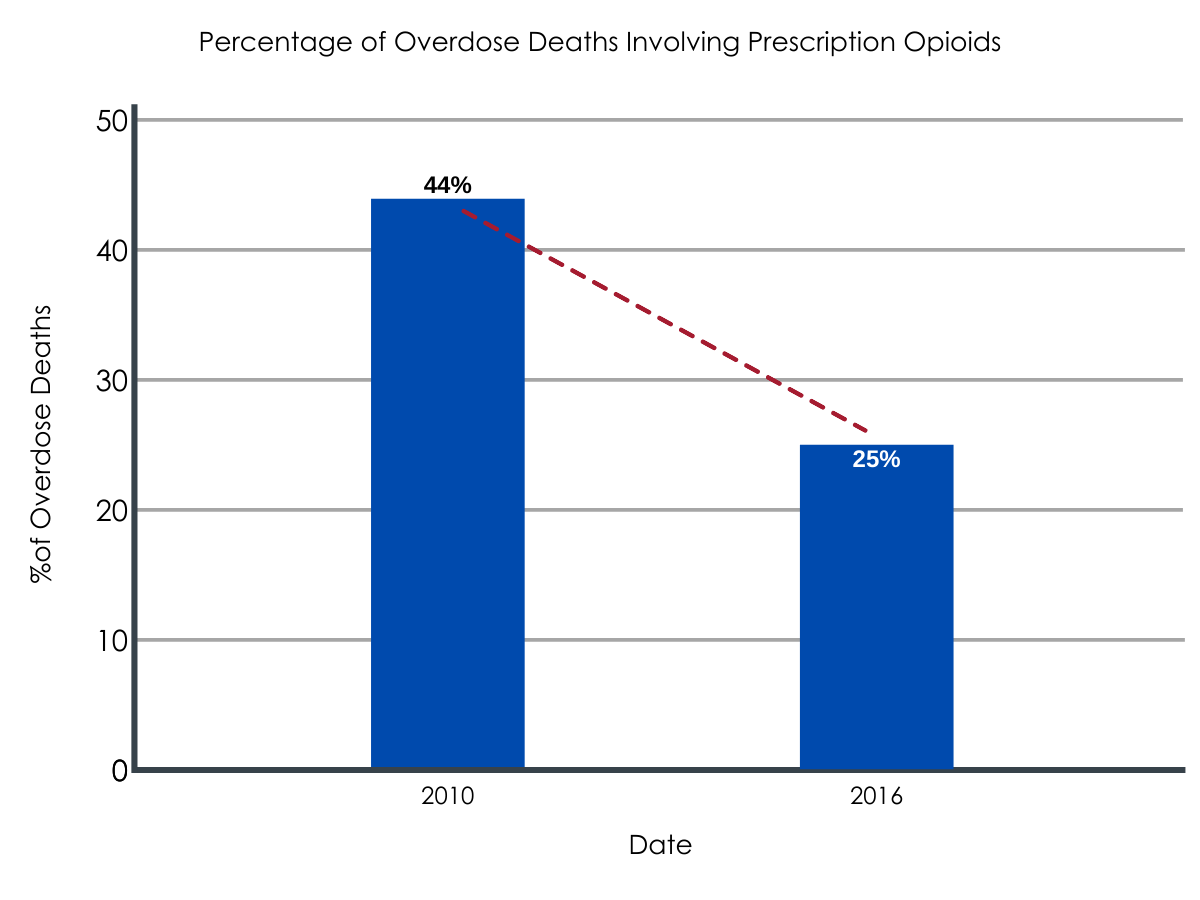
Figure 1. Depicts the percentage of all fatal drug overdoses that involved prescription opioids in the years 2010 and 2016.
The proportion of prescription opioid overdoses that also involved heroin and/or synthetic opioids like fentanyl increased between 2010 and 2016.
In 2010, 20 of the 365 prescription opioid overdose deaths also involved heroin and/or synthetic opioids. This rate was much higher in 2016, with 54 of the 216 prescription opioid overdose deaths also involving heroin and/or synthetic opioids.
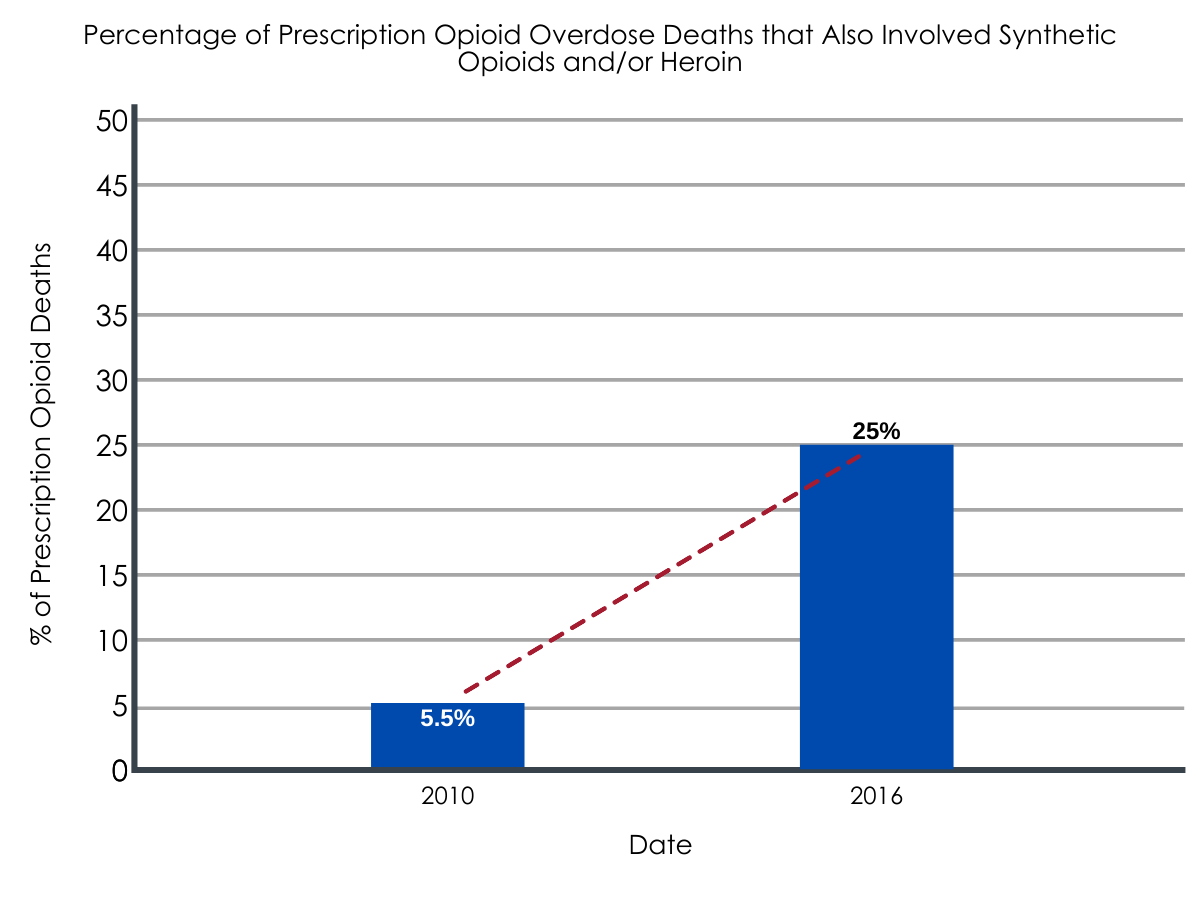
Figure 2. Presents the percentage of all prescription opioid overdose deaths that also involved heroin and/or synthetic opioids in the years 2010 and 2016.
About 1 out of 7 U.S. high-school students reported lifetime use of nonmedical prescription opioids and history of misuse was associated with a higher rate of heroin and injection drug use.
Fourteen percent of high-school students had engaged in nonmedical prescription opioid use within their lifetime. Students who reported lifetime history of prescription opioid misuse were much more likely to engage in heroin use (~9%) and injection drug use (~8%) than students who had not engaged in nonmedical prescription opioid use (0.4%).
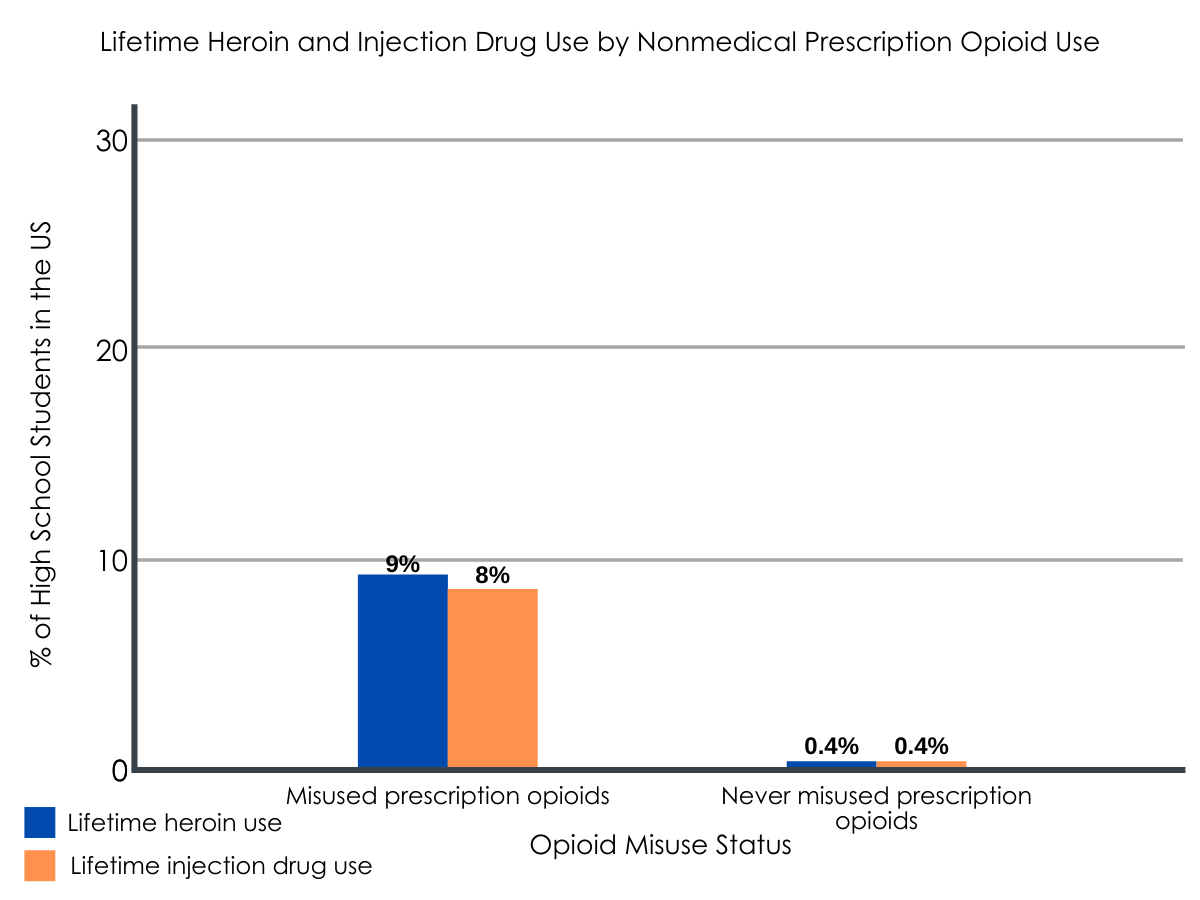
Figure 3. Depicts the percentage of high school students in the US who have ever engaged in heroin or injection drug use, and whether or not they have misused prescription opioids.
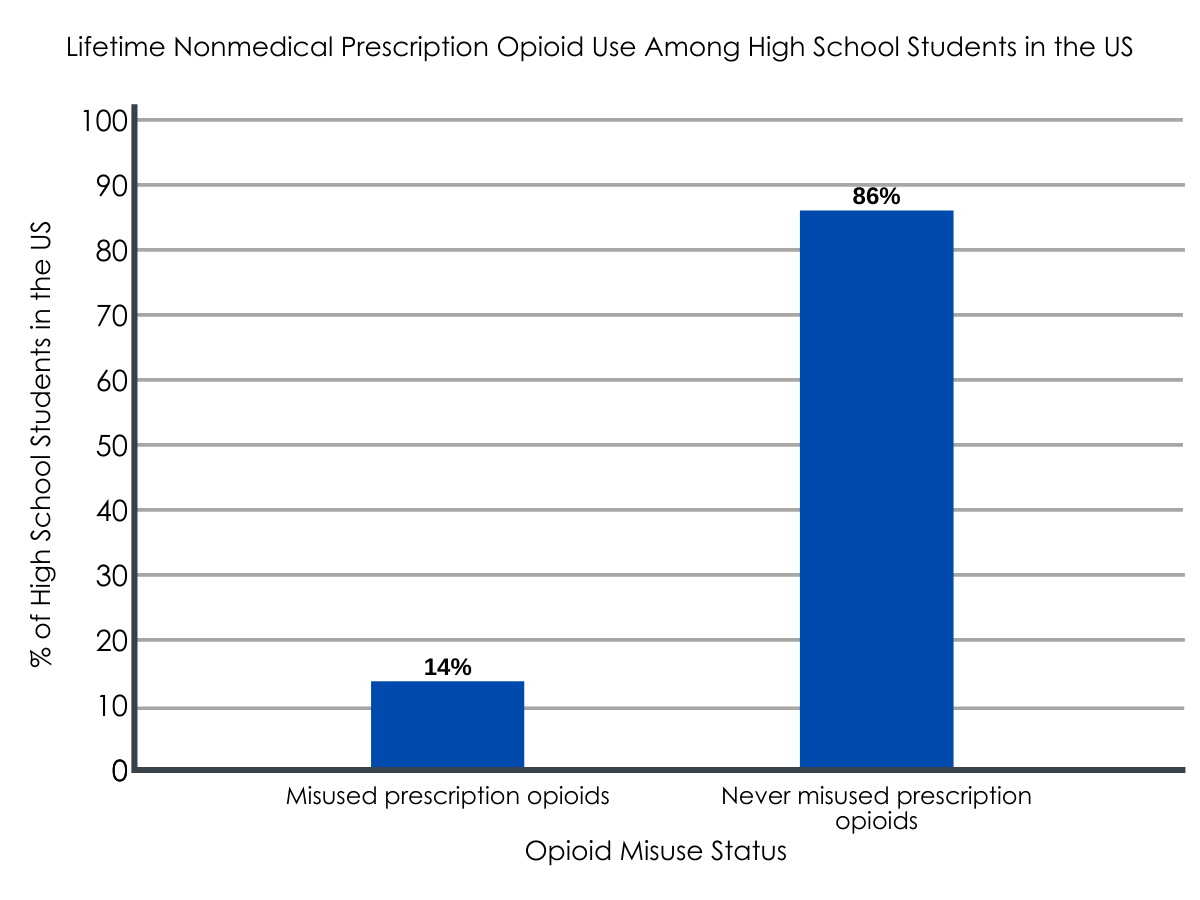
Figure 4. Depicts the percentage of overall US high school students who have misused or never misused prescription opioids.
Individuals who misused prescription opioids a greater number of times across their lifetime had higher rates of heroin and injection drug use.
Compared to individuals who had no history of nonmedical prescription opioid use, those who had misused prescription opioids 1-2 times, 3-19 times, and 20+ times were all more likely to have used heroin and injected drugs. Heroin and injection drug use were most prevalent among individuals who had misused prescription opioids 20+ times; heroin and injection drug use prevalence were significantly lower for those who had misused opioids 1-2 times and 3-19 times. Individuals who has misused prescription opioids 3-19 times were also more likely than those who used 1-2 times to have engaged in injection drug use.
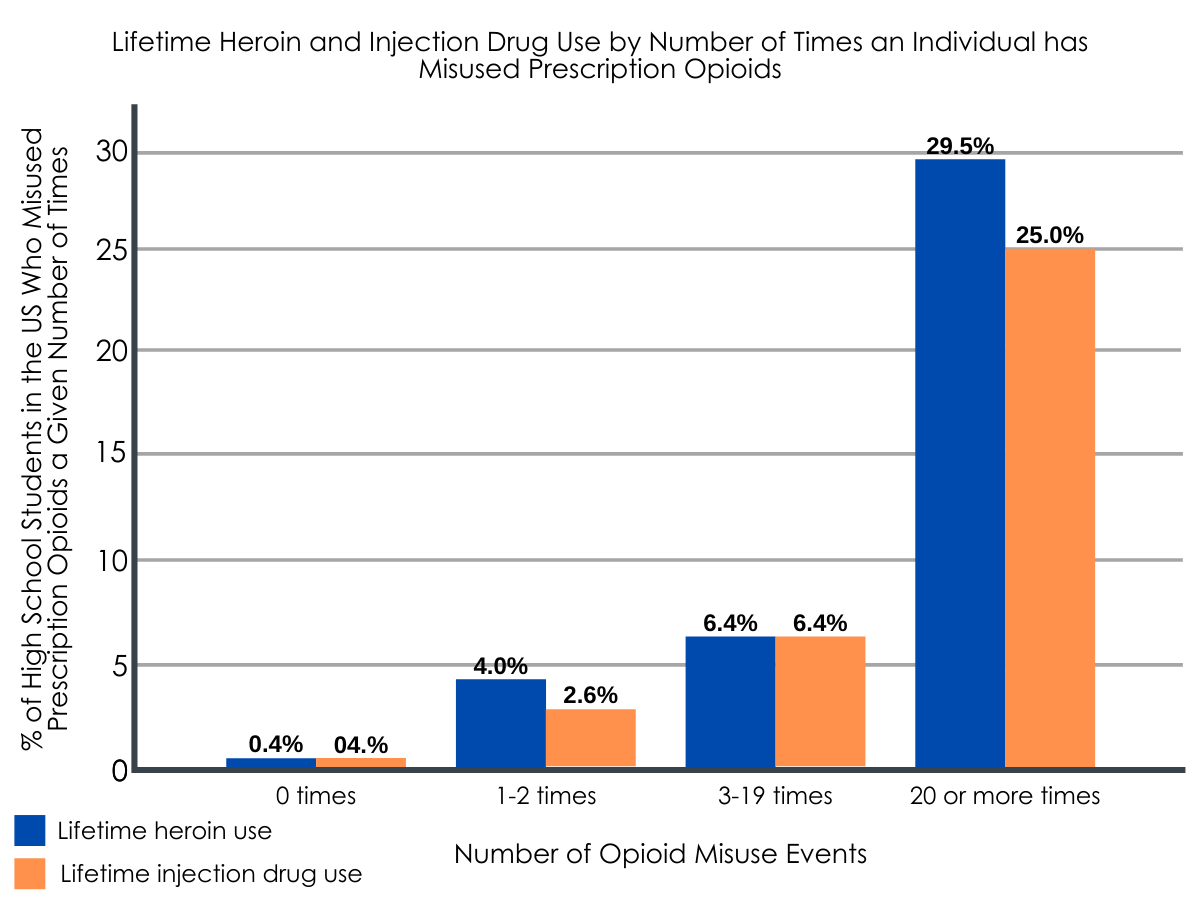
Figure 5. Depicts the percentage of students who have engaged in heroin use and injection drug use, by the number of times that individuals had misused prescription opioids in their lifetime.
WHAT ARE THE IMPLICATIONS OF THE STUDY FINDINGS?
Studies like this help us better understand opioid overdose and related risk factors that can ultimately shed light on novel interventions and prevention strategies for reducing overdose risk and mortality among adolescents and emerging adults.
Consistent with national survey data showing recent declines in nonmedical opioid use among adolescents and emerging adults, this study found a parallel decline in overall overdose deaths involving prescription opioids between 2010 and 2016. Despite this general decline, however, overdose deaths attributable to prescription opioids that also involved synthetic opioids or heroin significantly increased. This suggests that, although fewer individuals are engaging in nonmedical prescription opioid use, those that are engaging in it are more likely to be exposed to more dangerous substances. Whether this exposure is intentional or not is unclear, given that heroin and synthetic opioids like fentanyl can also be found in counterfeit prescription opioids and individuals may be consuming these additional substances unknowingly. On the other hand, some individuals may be experimenting with the use of various opioid-based substances and lack the tolerance necessary to avoid overdose because they have yet to engage in regular or daily use.
Importantly, when the authors looked at a survey of high school students, they found that heroin and injection drug use was significantly more common among individuals who had engaged in prescription opioid misuse, and using prescription opioids a greater number of times was associated with higher rates of heroin and injection drug use. This is concerning because of the greater overdose risk involved with these behaviors, but it also reveals important information about when it might be most appropriate to intervene. For example, conducting school- and family- based interventions (e.g., brief motivational interviews) among students who have misused prescription opioids a few times might help prevent subsequent use and transitions to more risky drug use behaviors, which could ultimately reduce risk of overdose and related mortality. Indeed, screening , brief intervention, and referral to treatment (SBIRT) in pediatric healthcare settings have shown to reduce the likelihood of adolescents and emerging adults developing substance use disorders.
Findings also suggest that individuals with more misuse experience (nonmedical prescription opioid use 20+ times) may require more intensive interventions and education regarding overdose mortality and infectious disease transmission, as they are more likely to engage in risky drug use behaviors (i.e. heroin and injection drug use). Still, students who only misused prescription opioids one or two times also had significantly increased risk of heroin and injection drug use, which highlights the additional need for prevention and educational efforts to reduce the prevalence of opioid misuse among adolescents and emerging adults in the first place. There has also been increased attention around prescribing anti-craving medications like Suboxone (buprenorphine) for adolescents and emerging adults with more severe opioid use disorders. However, research suggests that only a small proportion of youth utilize these lifesaving medications, highlighting an important treatment gap and the need for more research in this area.
Clearly, misuse of more than one kind of opioid is dangerous and contributes to increased risk of overdose mortality. This study suggests that there are an increasing number of adolescents and emerging adults who are dying from overdoses involving opioids that are assumed to have been initially prescribed for medical purposes (i.e., in pill form) as well as illicit, non-prescribed, opioids. As misuse of prescription opioids progresses, individuals might enhance their likelihood of encountering counterfeit pills that contain synthetic opioids like fentanyl, and may be more likely to engage in heroin use and injection drug use, which increases their risk of overdose and related death.
Given that the magnitude of risk for engaging in these behaviors increased with exposure, it is essential to develop prevention efforts to help educate adolescents and emerging adults about the serious risks of experimenting with opioids, and to develop adolescent-geared interventions that can help prevent further misuse and progression to more risky opioid use behaviors.
- LIMITATIONS
-
- This research was based on two separate datasets and direct links between opioid use behaviors and mortality could not be assessed. Furthermore, cause of death (i.e. drugs involved in deaths) on death certificates may not be accurately reported and reporting procedures often vary by state, heightening risk for misreported or undocumented cause of death. Longitudinal research can help further characterize transitions from prescription opioid misuse to heroin/synthetic opioid use and injection drug use, and how these use patterns influence mortality risk.
- Analyses did not account for the potential influence of substance use disorder diagnoses or their severity, treatment exposure, or other psychosocial risk factors on opioid use behaviors warranting further investigation.
- This study limited investigation to adolescents and emerging adults aged 15 to 19 years, and behavioral data was based on high-school students. Therefore, findings may not generalize to other adolescent and young adult populations outside of this age range and who do not, or no longer, attend high school.
BOTTOM LINE
Studies like this help us better understand opioid overdose among adolescents and factors that contribute to it, which can help guide new strategies for reducing opioid overdose and death. Focusing on individuals aged 15 to 19 years, this study found that adolescents and emerging adults who misused prescription opioids were more likely to have also used heroin and injected drugs, and the prevalence of these behaviors increased with the number of times individuals misused prescription opioids. Furthermore, an increasing number of adolescents in the U.S. appear to be dying from prescription opioid overdoses that also involve heroin and/or synthetic opioids like fentanyl, despite declining rates of overdose deaths involving prescription opioids alone. This is important because it suggests that more adolescents and emerging adults are using prescription opioids with heroin and/or synthetic opioids, whether intentional or not. More specifically, these results could suggest that adolescents are unknowingly experimenting with counterfeit prescription opioids that contain these more dangerous substances like fentanyl. Alternatively, some adolescents may be progressing from prescription opioid misuse to purposeful simultaneous use of illicit opioids. Additional research will help determine the reasons for increased mortality rates, and will help develop additional prevention and intervention strategies for educating adolescents and emerging adults about the dangers of opioids misuse and injection drug use, and preventing further misuse and progression to more risky opioid use behaviors.
- For individuals and families seeking recovery: Individuals and families with adolescents and emerging adults are encouraged to talk to their school systems and family doctors to identify educational materials that can help with opioid misuse prevention and intervention.
- For treatment professionals and treatment systems: Healthcare systems might consider screening , brief intervention, and referral to treatment (SBIRT) for adolescents and emerging adults in healthcare settings (e.g., family physician and pediatrician offices), as SBIRT is shown to reduce the likelihood of developing substance use disorders in this population.
- For scientists: Additional research is needed to determine if overdose deaths are due to purposeful combined use of prescription opioids with heroin/synthetic opioids, or unknown ingestion of heroin / synthetic opioids through the use of counterfeit prescription opioids. These data also highlight the need for novel intervention and prevention strategies to help reduce prescription opioid misuse, prevent transitions to the use of illicit opioid, and educate adolescents and emerging adults about the dangers of opioids misuse in modern day drug supplies as well as the dangers of combined use.
- For policy makers: Given that overdose deaths involving prescription opioids alone have declined, these findings could suggest increased prevalence of purposeful combined use of prescription opioids and illicit opioids, or unknown ingestion of heroin / synthetic opioids through the use of counterfeit prescription opioids that can unknowingly contain such substances. Additional funding for research would help determine the reasons underlying these shifts in prevalence estimates. It will also aid in the development of novel prevention and intervention strategies among adolescents and emerging adults to further address the opioid epidemic.
CITATIONS
Bohm, M. K., & Clayton, H. B. (2020). Nonmedical use of prescription opioids, heroin use, injection drug use, and overdose mortality in US adolescents. Journal of Studies on Alcohol and Drugs, 81(4), 484-488. doi: 10.15288/jsad.2020.81.484

